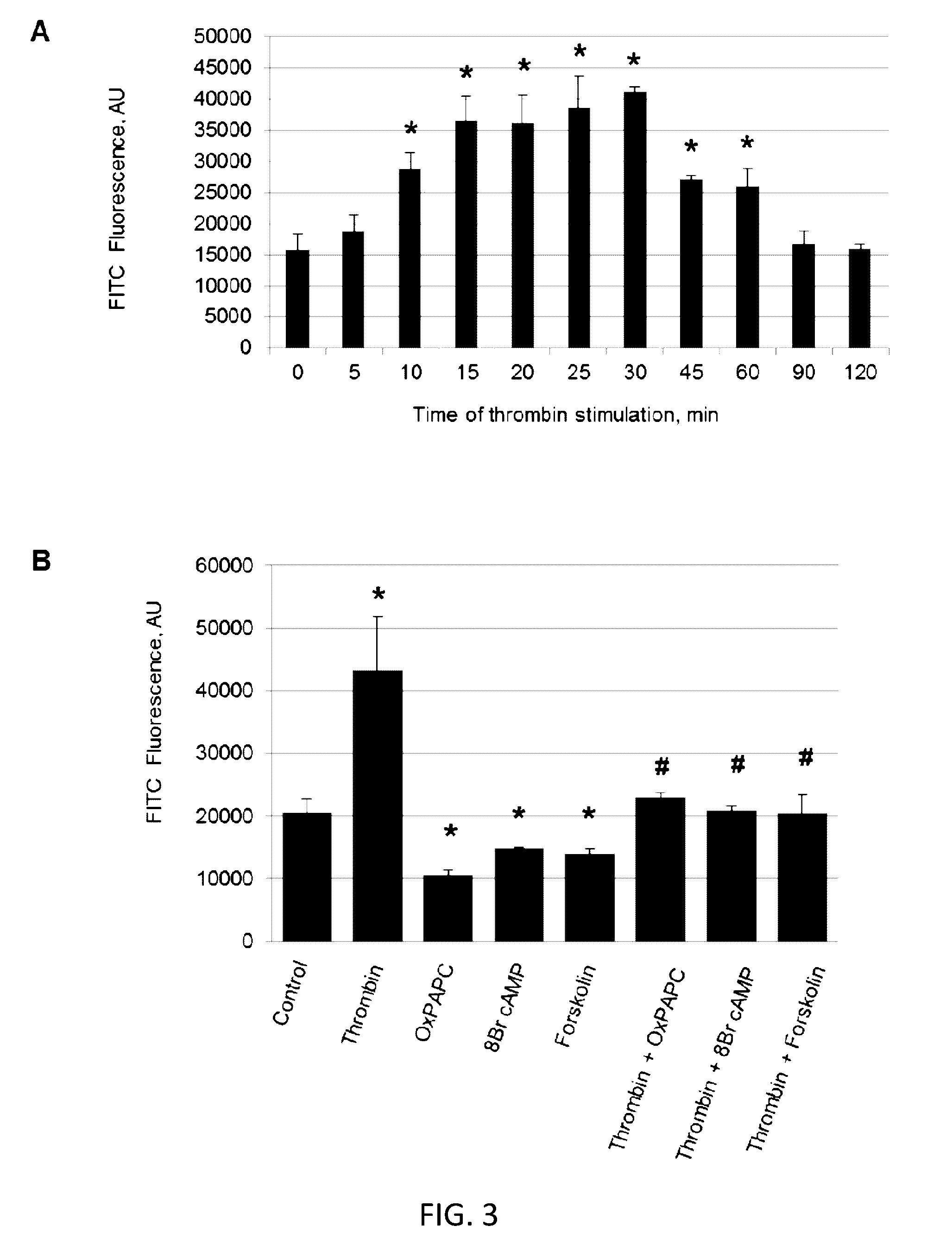Methods and compositions for measuring cell permeability
a cell permeability and composition technology, applied in the field of cell permeability measurement, can solve the problems of inability to evaluate permeability in endothelial or epithelial cells, inability to achieve spatial resolution of local changes in permeability, and high equipment requirements of the technique, etc., to achieve the effect of increasing reducing the cell permeability of the monolayer of cells, and no detectable effect on permeability
- Summary
- Abstract
- Description
- Claims
- Application Information
AI Technical Summary
Benefits of technology
Problems solved by technology
Method used
Image
Examples
example 1
Measurement of Local Permeability at Subcellular Level in Cell Models of Agonist- and Ventilator-Induced Lung Injury
[0085]Alterations of cell monolayer integrity and increased vascular permeability are associated with many pathologies including atherosclerosis, stroke, lung injury, cancer, digestive disorders and others. Current approaches to probe cell permeability require specific culture conditions and provide an average estimation of trans-monolayer permeability, while analysis of regional monolayer permeability in static and mechanically challenged monolayers at a single cell scale resolution remains unavailable. Provided herein is a new approach for visualization and rapid quantitation of trans-monolayer permeability based on high affinity interactions between substrate-bound acceptor and ligand in the culture medium. As demonstrated in the following Examples, general and local permeability responses to a spectrum of barrier protective and barrier disruptive agonists and their...
example 2
Exemplary Materials and Methods
[0086]Reagents.
[0087]Chemicals and reagents including collagen type-I (cat. #C3511) and gelatin (cat. # G2500) were obtained from Sigma-Aldrich (St. Louis, Mo.) unless noted otherwise. FITC-avidin and Texas-Red phalloidin and all reagents for immunofluorescence staining were obtained from Molecular Probes (Eugene, Oreg.). EZ-Link NHS-LC-LC-Biotin (cat. #21343) was purchased from Thermo Scientific (Rockford, Ill.). 8-Bromo-adenosine-3′,5′-cyclic monophosphate (8Br-cAMP) was purchased from EMD Millipore (Billerica, Mass.). Non-oxidized 1-palmitoyl-2-arachidonoyl-sn-glycero-3-phosphorylcholine (PAPC) was obtained from Avanti Polar Lipids (Alabaster, Ala.). Oxidized PAPC (OxPAPC) was obtained by exposure of dry lipid to air followed by mass-spectrometry analysis (Birukov et al., 2004). cMyc antibody was purchased from Santa Cruz Biotechnology (Santa Cruz, Calif.); VE-cadherin antibody was purchased from Cayman (Ann Arbor, Mich.). 96-well polystyrene plasti...
example 3
The Concept of XPerT Permeability Assay
[0101]To overcome the drawbacks of existing technologies, a culture plate surface underlying growing cells was utilized as a permeability detection surface. In this assay, the permeability is measured as the bulk amount of the fluorescently labeled ligand FITC-avidin) bound to the surface-immobilized high affinity acceptor underneath the cell monolayer (FIG. 1).
[0102]In the prototype assay, biotinylated gelatin absorbed on a polystyrene or silicon-based surface was used as the detection surface, and FITC-labeled avidin was used as the permeability tracer. This selection was dictated by 1) high affinity acceptor-ligand interaction (Kd≈1015) in most biological buffers (Green, 1963); 2) flexibility of biotinylation techniques that can be applied to different substrates; and 3) wide range of chemical conjugates of avidin and its bacterial analog streptavidin which can be used for various modes of detection (i.e. multicolor fluorescent or enzymatic-...
PUM
| Property | Measurement | Unit |
|---|---|---|
| equilibrium dissociation constant | aaaaa | aaaaa |
| time | aaaaa | aaaaa |
| time | aaaaa | aaaaa |
Abstract
Description
Claims
Application Information
 Login to View More
Login to View More - R&D
- Intellectual Property
- Life Sciences
- Materials
- Tech Scout
- Unparalleled Data Quality
- Higher Quality Content
- 60% Fewer Hallucinations
Browse by: Latest US Patents, China's latest patents, Technical Efficacy Thesaurus, Application Domain, Technology Topic, Popular Technical Reports.
© 2025 PatSnap. All rights reserved.Legal|Privacy policy|Modern Slavery Act Transparency Statement|Sitemap|About US| Contact US: help@patsnap.com



